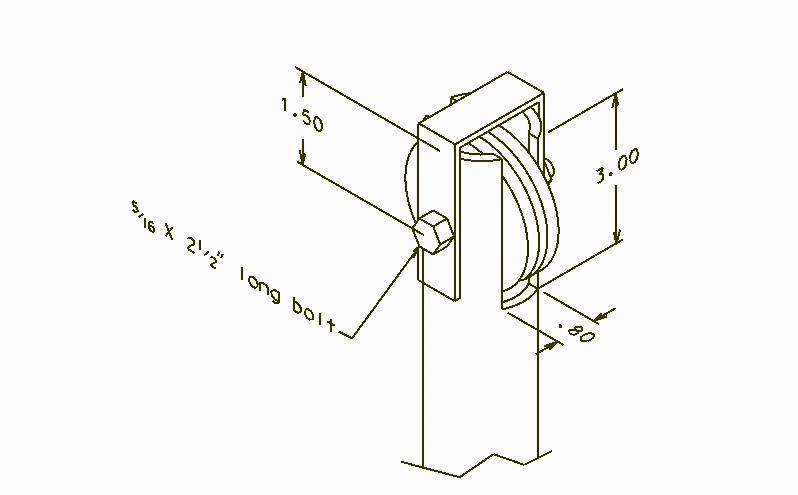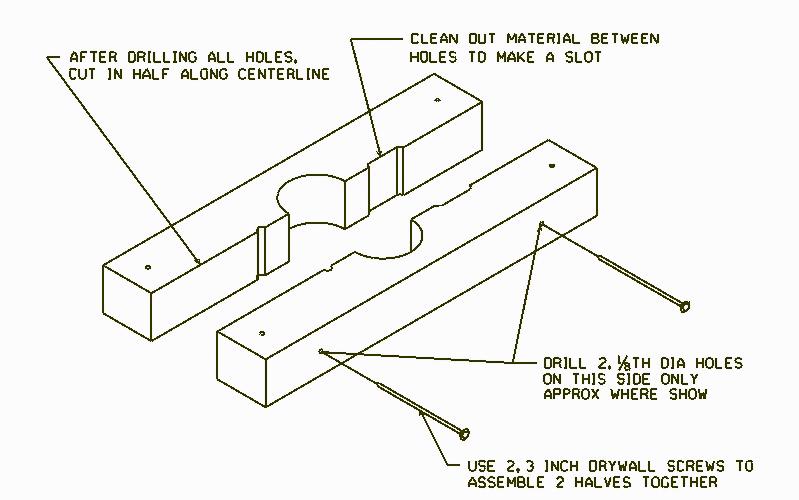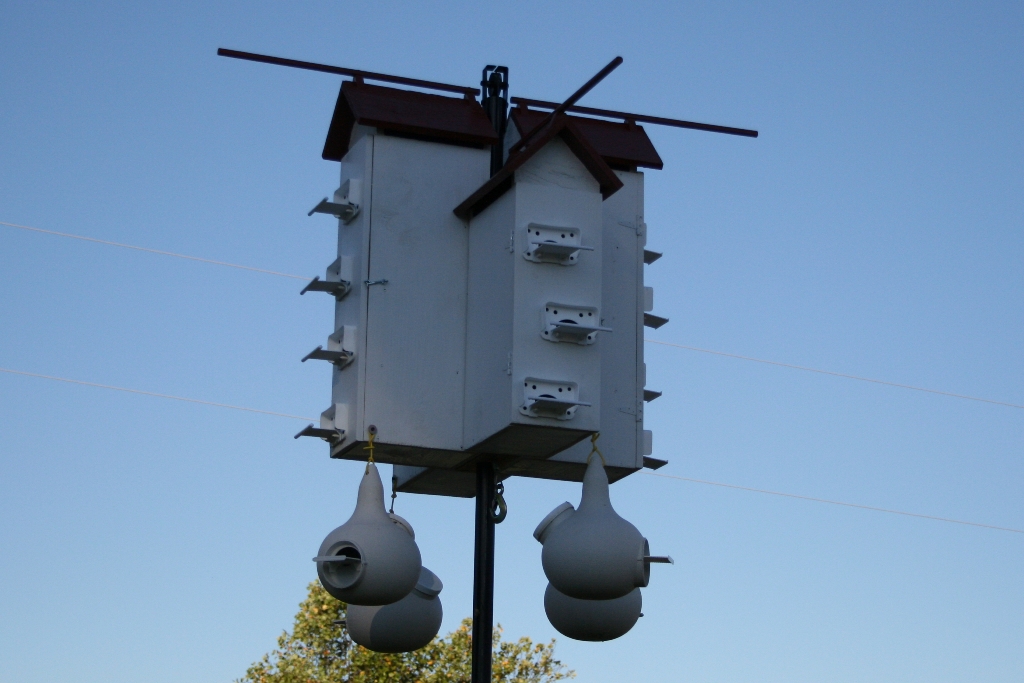
When you first purchase the plans for a T-14 Purple Martin House, they give
instructions on how to build and mount it to a square treated lumber pole.
However, I have all round steel poles at my site and because of all the
questions I've been asked about how I mounted my T-14 to a round metal pole, I
decided to create some drawings that would show my method. I realize that
not everyone is mechanical in nature, so I hope my drawings are clear enough for
all to understand. Hopefully between the drawings and descriptions, you'll
be able to make the pulley, safety strap and build the frame that mounts your
T-14 to a round pipe as I show on my page. It is important that any
housing for purple martins allows the vertical raising and lowering of the
house. This set-up does just that and it does it easily without any effort
on the landlords part. Since the house is too heavy to handle by hand, it
is assumed that a winch with a 3/16" (or even 1/4") steel cable is used to lift the
load. The pulley at the top of the pole is grooved to accept any cables
within that size range. If you do not have the ability to make the
pulley and strap, see the "Pulley and Safety Strap" section at the end
of this article.
PS:
I also have pictures and more descriptions of my actual frame that I use on my own T-14. You can go take a look and see for yourself what it looks and works like. Build your own T-14
About half way down the page there are a number of pictures that show how to actually build this frame.
Safety Note:
DO NOT USE ROPE FOR THIS DESIGN.
The following is the detail view of
the pulley and safety strap at the top of my pole that holds my T-14 martin
house up. As can be seen, the pulley is imbedded in the end of the pipe and held
in place by a 5/16" x 2 3/4" long bolt. The pulley is centered in the
slot with washers piled onto the bolt on each side of it to keep it
centered. Any commercial machine shop can manufacture these pulleys.
Simply print out this drawing and bring it to them.
The dimensions for the pulley are:
Material: Aluminum or UHMW with
UV inhibitors
2 3/4" Outside Diameter
.68" Thick
.32" Diameter hole in the middle
1/4" wide x 1/4" deep cable groove, centered on width
Safety strap:
.090 thk Aluminum
Inside width equals outside dia of pipe being used.
Mounting hole = clearance for bolt being used.
Mtg hole, down 2" from inside of bend.
Width = 1"
This design works very well with a winching system.

The safety strap over the pulley is required to prevent the cable from accidentally coming out of the pulley groove and can be made from either steel or aluminum, however if made from aluminum, rust is not an issue and it's much easier to work with.
The slot can be cut in the end of the pipe using a hand held hacksaw. Take your time and make it as close to the dimensions as possible. Then, drill the hole and add your pulley and safety strap.
Assuming you have already mounted your winch to the pole, feed the cable through the pulley insuring you are inside the safety strap. (If your winch already has a hook mounted to it, then you'll have to put the cable on the pulley before you can mount your safety strap). Then, string it down to the area where you will be adding your frame. This can be done before standing your pole up. Pass the end of the cable through a large nut, then double the cable back on itself and add a small cable clamp to the end of the cable. (These can be purchased at any hardware store). This forms a large knot at the end of the cable which does not allow it to pull through the frame cable hole. The nut is nothing more than a secondary safety device that will not allow the cable to come undone from the clamp.
This frame can be made from one 8 foot long piece of treated 2 x 4 lumber. Make sure you get one that is as straight and free of knots as possible. This makes for a better job when finished.
The following graphic shows the dimensions required to make the two blocks. These blocks are used to make the top and bottom of the frame that the house sections are mounted to. The T-14 is made in 4 sections, each mounting separately to the frame. To make the frame, measure the width of the back of one section of your T-14. That is the dimension for the length of your two horizontal members. Now, cut and make 2 of the following parts. A hand held drill and jig saw are the only two tools required to make these parts. While cutting, cut 2 - 18" long pieces of 2 x 4. These are the vertical members that will be used to make the final frame later. Nothing to do with these since they will be used as solid pieces.

Once all the holes are drilled in the two , use your jigsaw and cut them in half along the centerline indicated. It is best to mark the parts. Simply draw an angular line across each of them, but in different places so the lines match when they are put back together. Or you can mark them bottom and top if you prefer. The cuts from a jigsaw may not be perfect, but if kept together, the two parts will mate correctly.
Now using your jigsaw, clean out the material between the two 1/4 inch holes as indicated. This makes a slot when the parts are re-assembled which allows the cable freedom for movement when raising and lowering the house with the winch. These slots always go over the winch side of the pole.

When done, assembly can now begin.
Using only the two rear portions of the horizontal members, screw them on to the ends of the vertical members as shown in the 'Final Frame' drawing below. I lay mine done on a flat table or bench, insuring the holes are to the inside of the frame, so that everything lines up good, plus, it's easier to work with this way. This will give you a basic frame that doesn't have any front halves to the horizontal members.
Now, take the half-frame and the two half horizontal pieces to the pipe where it is to be mounted. Might need two people to hold all the parts in place until assembly is final. The following is said assuming the pole has been stood up and the cable has been threaded through the pulley at the top of the pole and is 'dead ended' on the downward end with the clamp. (Dead ended refers to adding a clamp to the free end of the cable forming a knot large enough so that it won't pull through the cable hole).
While the frame is held to the back of the pole, place the up side of the cable, (from the winch) in the half cable slot of BOTH horizontal members. Repeat this procedure for the knot end of the cable placing it in the half holes with the cable knot on the underside of the lower horizontal member. Now place the front half of the lower horizontal member (match the angular line to make sure you have the correct one) in position and insuring the cables are in proper position, screw it in place. Repeat for the top front half horizontal member. This now gives you a frame mounted on your pole as shown below.

This frame will be greatly increased structurally with the addition of the 4 housing sections, but first I strongly suggest if you plan on doing any painting that it be done at this time. Can't do that once the house is attached.
Now, decide which house sections you want to mount to the 'face' of the frame and on the back of the these two house sections, measure up 21" from the bottom and draw a horizontal line. Now screw a small block of wood about a 1/4" thick and 2" long to the back (and in the center) of each unit with the bottom of the block resting on the line. I used these blocks of wood to rest my house sections on the TOP horizontal frame member so that it's easier for me to work with. They are thin, but if held in place, they will hold the section in place until screwed in to the frame. The 21" allows for the bottom of the house to be flush with the bottom of the frame. You may want to make adjustments to this dimension depending on how you want to mount your house. I mounted my long sections of the house first and as can be seen in the photo below, the bottom of the house is even with the bottom of the frame..
From the bottom of the little block, measure down, 3/4" and draw another horizontal line across the back of the unit. 20 1/4" down from the block draw a second horizontal line across the back of the house. Now, on each of those lines, drill 2, 1/8" holes about 4" apart and centered on the house thru the back wall of each house section. These will be used for the screws that mount the house sections to the frame.
Now, assuming you want the bottoms of the house to line up, on the other two house sections, draw the same lines per the instructions as before, but this time, drill the holes only 2" apart. As can be seen in the picture, I wanted my short sections to be up 1 1/2", so I lowered my holding blocks by 1 1/2". No reason other than personal preference.
Then, using 4, 1 5/8" long galvanized decking screws, set (and center) the house section on the frame, resting the little holding blocks on the top of the frame. Screw the first unit in place. (I used my drill equipped with a long screw driver extension to get all the way to the back wall of the house).
NOTE: Before continuing, insure that the little block does not hit the pole or they will bind. If too thick, take them off and thin them down where they hit the pole. If they clear, then repeat for the opposite house section. Before going any further, insure that the frame slides freely on the pole. If so, then continue.
The other two sections of the house can now be added in the same fashion screwing into the vertical members of the frame. When all done, you should have a T-14 mounted to a round metal pole as shown below.

Now, you can make a winch run of your house. As you turn the winch and the house raises, notice the cable in the bottom cable slot. It should move freely in the slots. It moves with the increase or decrease of the size of the winch pulley. This is why there has to be a slot on the winch side of the frame.
One other thing I do for all my martin poles. I make ground sockets
so that I can easily lift the main pipes out of the ground should they require
any kind of maintenance or to put them away for the winter. My main pipes
are Schedule 40, but if you feel this may not be strong enough, then Schedule 80
is stronger and is readily available, but the cost is higher.
Below is a drawing showing how to make a ground socket from Schedule 40 pipe. The main pipe diameter is 1.9 inches Outside Diameter. The socket inside diameter is 2.06 and will allow the main pipe to fit down inside of it very easily. Cut the notch at the bottom of the main pipe to prevent twisting once installed. This ground socket should be buried in concrete with the top of the socket at ground level. Then the main pipe can be removed when ever required. Also, with the top of the socket at ground level, no one will trip over them and also, the mower will slip over the top of them without ruining the mower blades. Then the main pipes can be replaced any time you like.
The main pipes fit fairly loose in the socket, so what I do is push the main pipe to one side and then place 2 - 16 penny spikes beside it down into the ground socket. The heads of the spikes hold the pole to one side so that it doesn't rock in the ground socket and can easily be removed when the main pole needs to be removed.
Note: If you decide on pipe sizes other than given, make sure the two pipes will fit together before you do any work. And, please make sure the pipes are strong enough to do the job. Pipes smaller and thinner in wall thickness are NOT strong enough to hold the weight of a T-14. Schedule 80 is a very good thickness steel pole to use for T-14 style housing.

Also note:
I do not sell the plans to the T-14. The PMCA has them.